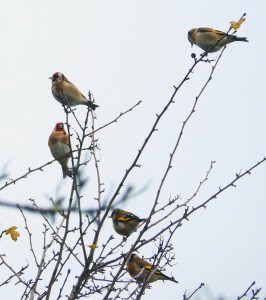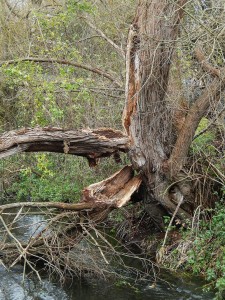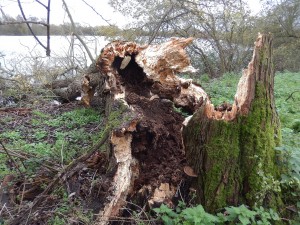
A twittering, constantly moving flock of a dozen Goldfinches greeted my arrival at Wraysbury. The wind was already keen and I was glad of my thick fleece and waterproof jacket. A few Wood Pigeons and a Crow or two blew down the wind, hardly needing to flap. Even a Heron, doing its best to flap downwind as usual, rocketed past in the swift airstream. A solitary Fieldfare chattered to me from a bare thorn tree, its chack-chack unmistakable.

The stormy winds of the weekend had broken several large willows including the big one just North of the bridge: two branches had fallen, cracking off what are now revealed to be fragments of the hollow shell of the trunk. Willows and poplars are dangerous as the trunks are short-lived and often rotten inside: and the fast-growing branches can be very thick and heavy.

This tree by the lake snapped its seemingly solid, reassuringly mossy trunk and fell into the water. It was quite hollow, filled with soft brown beetle frass with finger-thick borings. Notice, however, the bracket fungus near the base.

The lake was covered in winter wildfowl, as the Channel at dawn on D-Day was covered with ships. I gave up trying to count the hundreds of Gadwall; there were dozens of Wigeon and Tufted Ducks, and plenty of Mute Swans, Canada Geese and Coots too. A few Cormorants, some with very white bellies, and a Great Crested Grebe or two made up the numbers. As I raised my binoculars, a Kingfisher darted from the near bank and raced right across the lake, perching on the far side.
